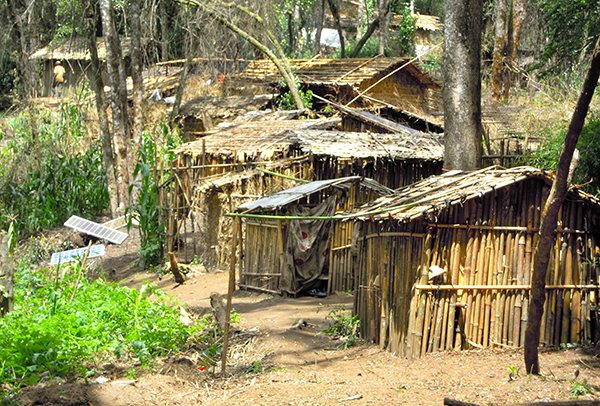The different faces of violence
Social anthropologist Anna Hedlund has studied violence in places like Fiji, Papua New Guinea, Bouganville and the Solomon Islands, all the while knowing that it was in the eastern Congo that exposure was at its worst. How do the underlying political, economic and social mechanisms work in war zones? Deep in the Congolese forests she met with perpetrators in the Hutu militia’s own rebel camp.
Five days of walking brought Anna Hedlund to a closed world, which few have access to. The FDLR rebel camp which has been around for 20 years reminds you of a refugee camp without running water, electricity and very little access to food, water, medicine and blankets to protect against the cold and rain storms. Both rebel warriors and civilians live in the camp. The story goes a long way back, before the colonial era in Rwanda. In a conflict-ridden country, the Hutu nationalist party came into power through elections in 1959 and tried to improve the living conditions for the Hutu. The ethnic tensions between the Tutsis and Hutus were intensified and culminated in one of the world’s largest genocides of Tutsis in 1994, where the official number of deaths from 6 April to early July of that year was 937 000. The UN and Western countries were aware of the dramatic progress, but remained passive – something the UN has subsequently had to face harsh criticism for.
Hutus came to Congo as refugees. After years of exile, fear, and in an environment of propaganda and political beliefs, Hutus are still today – 20 years after the genocide – in a state of war.
“I was very surprised that there were so many civilian refugees living in the camp; women, children, the elderly. Sure, it was a military camp, but it was also a community with schools and churches, albeit isolated and with a clear military hierarchy.”
Who is the victim and who is the perpetrator? That is the question that Anna Hedlund wanted to dig into during her 15 months of fieldwork in the Congo.
“Most of the FDLR members that I interviewed told me that they wanted to return to Rwanda and start a new life, go to school and raise a family. There was great bitterness that UNHCR and other organisations do not attend to the civilian population and help them receive refugee status. Because they are an armed group, they have no rights. They wanted to leave the life in the forest but cannot return to Rwanda because they are in conflict with the government; they cannot stay in the Congo because they do not have citizenship; and they cannot get to a third country to seek asylum.”
FDLR Is not A homogeneous group but a composition of extremists, refugees, supporters, victims and perpetrators, and they all have different stories to tell. But many of the Hutu militias also carry a political conviction about wanting to restore the Hutu power in Rwanda and that the genocide did not happen in the way that has become official history: that the Hutu population are perpetrators and the Tutsis are victims.
“This is part of their propaganda. We are not to forget that many of those who assume a role as a victim have committed serious war crimes and continue to exercise violence. But it is a political conflict that is long and complicated; a conflict about history, representativeness, identity and power. The leaders also have an interest in retaining the Hutu population in the Congo because they themselves cannot return to Rwanda, as they are liable to be tried for the war crimes they have committed.”
In your doctoral dissertation “Exile Warriors: Violence and Community among the Hutu Rebels in the Eastern Congo” you want to answer the question: What is it that makes people expose others to violence? Have you found an answer?
“Yes, I believe I have gained a broader understanding of how they justify the violence they carry out. I certainly do not support their political and ideological beliefs, and nothing can justify the violence they have exposed other people to. But in their perception of history they are the victims through the attacks on the Hutu and the years of war in the Congo. Alienation, isolation, violence and a life on the run is the only reality they know, and many children grow up here. Despair about the future is widespread.”
Anna Hedlunds’ time in Congo has left its mark, and for many Hutus, she was the only contact with the outside world; there was an expectation of help.
“It was a difficult environment to work and be in. Although I felt safe in the camp, I was clearly aware that this is a group in war. Trust amongst people was low. There were always a lot of rumours, emotions, painful memories, grief, hatred and despair, leaving little room for dreams about the future. At the same time, however, I gained a new perspective of what living in war is like. The routines created in everyday life, the strategies they used to cope with everyday matters, faith, religion, and that even in the midst of all the hopelessness and despair, there was joy and a sense of community. Many have never lived a life outside of war and conflict, and they create an everyday life based on the reality that they are in.”
Anna Hedlund’s research will reach a wider audience with the help of a book contract.
“How is violence produced and reproduced? That is what I want the reader to gain insight into. I also want the book to lead to a more nuanced picture of who are the victims and who are the perpetrators, and that people can be both.”
Text: Bodil Malmström
Photo: Anna Hedlund


